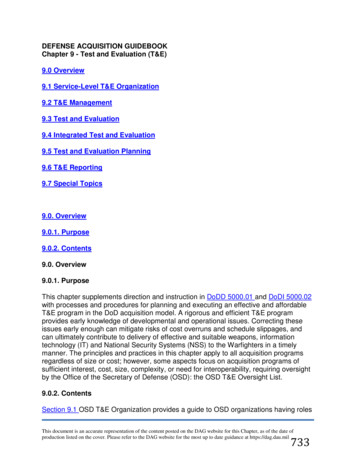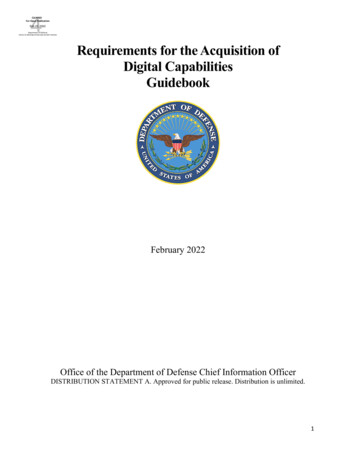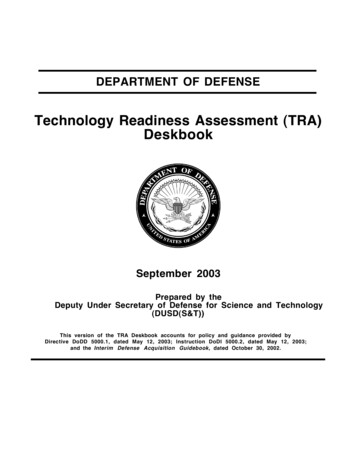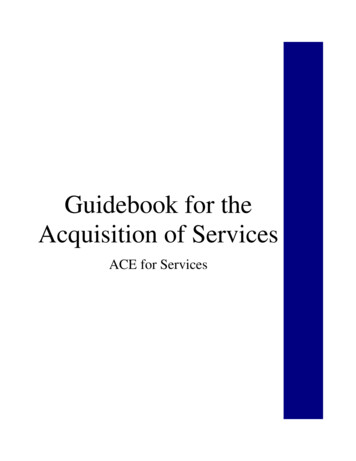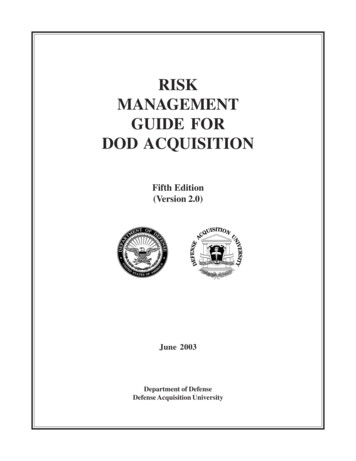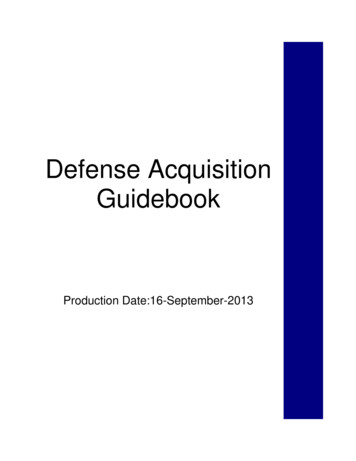
Transcription
Defense AcquisitionGuidebookProduction Date:16-September-2013
DEFENSE ACQUISITION GUIDEBOOK ForewordThe Defense Acquisition System exists to manage the Nation's investments intechnologies, programs, and product support necessary to achieve the NationalSecurity Strategy and support the United States Armed Forces. In that context, ourobjective is to acquire quality products that satisfy user needs with measurableimprovements to mission capability at a fair and reasonable price. The fundamentalprinciples and procedures that the Department follows in achieving those objectives aredescribed in DoD Directive 5000.01 and DoD Instruction 5000.02 .The Defense Acquisition Guidebook is designed to complement those policy documentsby providing the acquisition workforce with discretionary best practice that should betailored to the needs of each program.Acquisition professionals should use this Guidebook as a reference source supportingtheir management responsibilities. As an "on-line" resource, the information is limitedonly by the users interest or need. Some chapters contain general content; they provideindividual topic discussions and describe processes and considerations that will improvethe effectiveness of program planning. Some chapters may provide a tutorial on theapplication of these topics to the acquisition framework. Depending on the subjectmatter, a chapter may contain general background information, tutorial discussions,and/or discussions of the detailed requirements for each milestone decision and phase.All chapters contain non-mandatory staff expectations for satisfying the mandatoryrequirements in DoD Instruction 5000.02.Each chapter is designed to improve understanding of the acquisition process andensure adequate knowledge of the statutory and regulatory requirements associatedwith the process. Discussions, explanations, and electronic links to related informationenable the "reader" to be efficient, effective, innovative, and disciplined, and toresponsively provide warfighting capability. Each chapter lists potential ways theprogram manager or assigned manager can satisfy mandatory process requirementsand meet staff expectations for other activities. Differences of view regardingdiscretionary practice will be resolved by the Milestone Decision Authority.The Guidebook is intended to be an electronic reference source rather than a "book."The "reader" "navigates" the information instead of "leafing" through hundreds ofphysical, collated pages. "Navigation" is electronic movement through the referencesystem.Chapter 1, Department of Defense Decision Support Systems , presents an overview ofthe Defense Department's decision support systems for strategic planning and resourceallocation, the determination of capability needs, and the acquisition of systems.Chapter 2, Program Strategies , provides information and guidance needed to developa Technology Development Strategy and to develop and maintain a program-levelThis document is an accurate representation of the content posted on the DAG website for this Chapter, as of the date ofproduction listed on the cover. Please refer to the DAG website for the most up to date guidance at https://dag.dau.mil2
Acquisition Strategy.Chapter 3, Affordability and Life-cycle Resource Estimates , addresses acquisitionprogram affordability and resource estimation and describes the concept of programlife-cycle cost and the processes for conducting Analysis of Alternatives. The chapterdiscusses specific milestone review procedures, expectations, and best practices for avariety of topics related to acquisition program affordability, cost, and manpower. Thechapter further describes the role of both DoD Component cost estimates andindependent cost estimates in support of the DoD acquisition system.Chapter 4, Systems Engineering , outlines DoD guidance on systems engineering, andexplains expectations for completing the Systems Engineering Plan (SEP). The chapterdescribes standard systems engineering processes and how they apply to the DoDacquisition system. It addresses the systems engineering principles that a programmanager should apply to achieve a balanced system solution.Chapter 5, Life-cycle Logistics , provides the associated guidance the ProgramManager (PM), Product Support Manager (PSM), and Life-Cycle Logisticians can use ininfluencing the design and providing effective product support.Chapter 6, Human Systems Integration , addresses the human systems elements of thesystems engineering process. It will help the program manager design and developsystems that effectively and affordably integrate with human capabilities and limitations;and it makes the program manager aware of the staff resources available to assist inthis endeavor.Chapter 7, Acquiring Information Technology, Including National Security Systems ,explains how the Department of Defense complies with statutory and regulatoryrequirements for acquiring Information Technology and National Security Systems andin using a network-centric strategy to transform DoD warfighting, business, andintelligence capabilities. The chapter also provides descriptions and explanations of theClinger-Cohen Act and many other associated topics and concepts, and discussesmany of the activities that enable the development of net-centric systems.Chapter 8, Intelligence Analysis Support to Acquisition , provides information to enablethe program manager to use intelligence information and data to ensure maximum warfighting capability at the minimum risk to cost and schedule.Chapter 9, Test and Evaluation , supplements direction and instruction in DoDD5000.01 and DoDI 5000.02 with processes and procedures for planning and executingan effective and affordable T&E program in the DoD acquisition model. The chapter isdesigned to assist the program manager in the development of a robust, integrated, andeffective test and evaluation strategy to assess operational effectiveness and suitability,and to support program decisions.Chapter 10, Decisions, Assessments, and Periodic Reporting , discusses majorThis document is an accurate representation of the content posted on the DAG website for this Chapter, as of the date ofproduction listed on the cover. Please refer to the DAG website for the most up to date guidance at https://dag.dau.mil3
program decisions and tailoring based on program type and acquisition category,executive-level decision forums and the tenets and processes of Integrated ProductTeams (IPTs), program assessments, and periodic reporting. Additional chapter topicsinclude exit criteria, independent assessments, Acquisition Baseline Plan developmentand management, and periodic reports for Major Acquisition Programs and MajorAutomated Information Systems programs. The chapter also addresses Should-Costwith a focus on controlling the cost of the actual work that the Department is doing andexpects to do.Chapter 11, Program Management Activities , explains the additional activities anddecisions required of the program manager, not otherwise discussed in other chaptersof this Guidebook.Chapter 12, Business Capability Life Cycle , provides guidance for executing theBusiness Capability Lifecycle (BCL) and acquisition of defense business systems(DBS). BCL is the overarching framework for the planning, design, acquisition,deployment, operations, maintenance, and modernization of DBS.Chapter 13, Program Protection , provides guidance and expectations for the majoractivities associated with Program Protection.Chapter 14, Acquisition of Services , provides acquisition teams with a disciplined,three-phase, seven step process, for the acquisition of services.This document is an accurate representation of the content posted on the DAG website for this Chapter, as of the date ofproduction listed on the cover. Please refer to the DAG website for the most up to date guidance at https://dag.dau.mil4
DEFENSE ACQUISITION GUIDEBOOKChapter 1 -- Department of Defense Decision Support Systems1.0. Overview1.1. Integration of the DoD Decision Support Systems1.2. Planning, Programming, Budgeting and Execution (PPBE) Process1.3. Joint Capabilities Integration and Development System (JCIDS)1.4. Defense Acquisition System1.0. Overview1.0.1. Purpose1.0.2. Contents1.0.1. PurposeThis chapter provides background information about the environment in which theDepartment of Defense must operate to acquire new or modified materiel or services.1.0.2. ContentsSection 1.1 presents an overview of each of the three, principal, decision supportsystems used in the Department of Defense to acquire materiel and services, anddescribes the integration of those systems. Sections 1.2 through 1.4 provide details ofeach of these systems: Section 1.2 discusses the Planning, Programming, Budgeting,and Execution process, employed by the Department of Defense to conduct strategicplanning and make resource allocation decisions; Section 1.3 discusses the JointCapabilities Integration and Development System used to determine military capabilityneeds; and Section 1.4 discusses the formal Defense Acquisition System used toacquire that capability.1.1. Integration of the DoD Decision Support Systems1.1. Integration of the DoD Decision Support SystemsThe Department of Defense has three principal decision-making support systems, all ofwhich have been significantly revised over the past few years. These systems are thefollowing:This document is an accurate representation of the content posted on the DAG website for this Chapter, as of the date ofproduction listed on the cover. Please refer to the DAG website for the most up to date guidance at https://dag.dau.mil5
Planning, Programming, Budgeting and Execution (PPBE) Process - TheDepartment's strategic planning, program development, and resource determinationprocess. The PPBE process is used to craft plans and programs that satisfy thedemands of the National Security Strategy within resource constraints.Joint Capabilities Integration and Development System (JCIDS) - The systematicmethod established by the Chairman of the Joint Chiefs of Staff for identifying,assessing, and prioritizing gaps in joint warfighting capabilities and recommendingpotential solution approaches to resolve these gaps. CJCS Instruction 3170.01 and theJCIDS Manual describe the policies and procedures for the requirements process.Defense Acquisition System - The management process by which the Departmentacquires weapon systems, automated information systems, and services. Although thesystem is based on centralized policies and principles, it allows for decentralized andstreamlined execution of acquisition activities. This approach provides flexibility andencourages innovation, while maintaining strict emphasis on discipline andaccountability.Illustrated together in Figure 1.1.F1, the three systems provide an integrated approachto strategic planning, identification of needs for military capabilities, systems acquisition,and program and budget development. The next three sections provide briefintroductions to each of these decision support systems.Figure 1.1.F1. DoD Decision Support SystemsThis document is an accurate representation of the content posted on the DAG website for this Chapter, as of the date ofproduction listed on the cover. Please refer to the DAG website for the most up to date guidance at https://dag.dau.mil6
1.2. Planning, Programming, Budgeting and Execution (PPBE) Process1.2. Planning, Programming, Budgeting and Execution (PPBE) ProcessThe purpose of the PPBE process is to allocate resources within the Department. It isimportant for program managers and their staffs to be aware of the nature and timing ofeach of the events in the PPBE process, since they may be called upon to providecritical information that could be important to program funding and success.In the PPBE process, the Secretary of Defense establishes policies, strategy, andprioritized goals for the Department, which are subsequently used to guide resourceallocation decisions that balance the guidance with fiscal constraints. The PPBEprocess consists of four distinct but overlapping phases:Planning. The planning phase of PPBE is a collaborative effort by the Office of theSecretary of Defense and the Joint Staff, in coordination with DoD components. Itbegins with a resource-informed articulation of national defense policies and militarystrategy known as the Defense Planning Guidance (DPG). The DPG is used to lead theoverall planning process.Programming. The programming phase begins with the development of a ProgramObjective Memorandum (POM) by each DoD Component. This development seeks toconstruct a balanced set of programs that respond to the guidance and priorities of theDPG within fiscal constraints. When completed, the POM provides a fairly detailed andcomprehensive description of the proposed programs, including a time-phasedallocation of resources (forces, funding, and manpower) by program projected five yearsinto the future. In addition, the DoD Component may have the opportunity to describeimportant programs not fully funded (or not funded at all) in the POM, and assess therisks associated with the shortfalls. The senior leadership in OSD and the Joint Staff,and Combatant Commands review each POM to help integrate the DoD ComponentPOMs into an overall coherent defense program. In addition, the OSD staff ,the JointStaff, and Combatant Commands can raise issues with any section of a POM andpropose alternatives with adjustments to resources. Proposed programmatic changesare presented to the leadership for review, and decisions are documented in theResource Management Decision (RMD) document. DoD Components use the RMD toupdate their POM data sets which are then incorporated into the Departments Budgetand Future Years Defense Program (FYDP) and submitted to the Office of Managementand Budget (OMB) as part of the President’s budget request.Budgeting. The budgeting phase of PPBE occurs concurrently with the programmingphase; each DoD Component submit’ s it’s proposed Budget Estimate Submission(BES) simultaneously with its POM. The budget converts the programmatic view intothe format of the congressional appropriation structure, along with associated budgetjustification documents. The budget is focused on one year, but with considerably morefinancial details than the POM. Upon submission, each budget estimate is reviewed byanalysts from the office of the Under Secretary of Defense (Comptroller) and OMB.This document is an accurate representation of the content posted on the DAG website for this Chapter, as of the date ofproduction listed on the cover. Please refer to the DAG website for the most up to date guidance at https://dag.dau.mil7
Their review ensures that programs are funded in accordance with current financialpolicies, and are properly and reasonably priced. Proposed budget changes arepresented to leadership for review and decisions are documented in the ResourceManagement Decision (RMD) document. DoD Components use the RMD to updatetheir BES data sets which are then incorporated into the Departments Budget andFYDP and submitted to OMB as part of the President’s budget request.Execution. The execution review occurs simultaneously with the program and budgetreviews. The execution review provides feedback to the senior leadership concerningthe effectiveness of current and prior resource allocations. Metrics are used to supportthe execution review to measure actual output versus planned performance for defenseprograms. To the extent performance goals of an existing program are not being met,the execution review may lead to recommendations to adjust resources and/orrestructure programs to achieve desired performance goals.1.3. Joint Capabilities Integration and Development System (JCIDS)1.3. Joint Capabilities Integration and Development System (JCIDS)JCIDS plays a key role in identifying the capabilities required by the warfighters tosupport the National Security Strategy, the National Defense Strategy , and the NationalMilitary Strategy. Successful delivery of those capabilities relies on the JCIDS processworking in concert with other joint and DOD decision processes. JCIDS proceduressupport the Chairman and Joint Requirements Oversight Council (JROC) in advising theSecretary of Defense on identifying and assessing joint military capability needs. JCIDSis a joint-concepts-centric capabilities identification process that allows joint forces tomeet future military challenges. The JCIDS process assesses existing and proposedcapabilities in light of their contribution to future joint concepts. The JCIDS process wascreated to support the statutory requirements of the JROC to validate joint warfightingrequirements. JCIDS is also a key supporting process for the DOD acquisition andPlanning, Programming, and Budget Execution (PPBE) processes . The primaryobjective of the JCIDS process is to ensure the capabilities required by the jointwarfighter to successfully execute the missions assigned to them are identified with theirassociated operational performance criteria. This is done through an open process thatprovides the JROC the information they need to make decisions on requiredcapabilities. The requirements process supports the acquisition process by providingvalidated capability needs and associated performance criteria to be used as a basis foracquiring the right weapon systems. Additionally, JCIDS provides the PPBE processwith affordability advice supported by the capabilities-based assessment (CBA) , andidentifies capability gaps and potential materiel and non-materiel solutions. While itconsiders the full range of doctrine, organization, training, materiel, leadership andeducation, personnel and facilities (DOTMLPF) solutions, for purposes of thisGuidebook, the focus is on the pursuit of "materiel" solutions.JCIDS acknowledges the need to project and sustain joint forces and to conductflexible, distributed, and highly-networked operations. JCIDS is consistent with DoDThis document is an accurate representation of the content posted on the DAG website for this Chapter, as of the date ofproduction listed on the cover. Please refer to the DAG website for the most up to date guidance at https://dag.dau.mil8
Directive 5000.01 direction for early and continuous collaboration throughout theDepartment of Defense. JCIDS implements a capabilities-based approach thatleverages the expertise of government agencies, industry, and academia. JCIDSencourages collaboration between operators and materiel providers early in theprocess. JCIDS defines interoperable, joint capabilities that will best meet the futureneeds. The broader DoD acquisition community must then deliver these technologicallysound, sustainable, and affordable increments of militarily useful capability to thewarfighters.JCIDS informs the acquisition process by identifying and assessing joint militarycapability needs which need a materiel solution; these identified capability needs thenserve as the basis for the development and production of acquisition programs. JCIDSis fully described in CJCS Instruction 3170.01 , signed by the Director of the Joint Chiefsof Staff. This instruction establishes the policies for JCIDS, and provides a top-leveldescription of the process. A supplementary on-line manual, the JCIDS Manual ,provides the details necessary for the day-to-day work in identifying, describing, andjustifying joint warfighting capabilities. The manual also includes the formats thatdescribe the content required for each JCIDS document.For major defense acquisition programs or major automated information systemssubject to OSD oversight, the products of the Joint Capabilities Integration andDevelopment System process directly support the Defense Acquisition Board (DAB) inadvising the Milestone Decision Authority for major milestone decisions. Figure 1.3.F1 isa simplified portrayal of the nature of this support. JCIDS provides similar support toother acquisition programs, regardless of the milestone decision authority. Whereappropriate, the JCIDS process and its products may be tailored when applied toautomated information systems.This document is an accurate representation of the content posted on the DAG website for this Chapter, as of the date ofproduction listed on the cover. Please refer to the DAG website for the most up to date guidance at https://dag.dau.mil9
Figure 1.3.F1. JCIDS and Defense AcquisitionCapabilities-Based Assessment Users GuideFigure 1.3.F1 depicts several key points. First, JCIDS is based on a series of top-downanalyses ultimately derived from formal strategic-level guidance, including the NationalSecurity Strategy, National Defense Strategy, National Military Strategy and the Reportof the Quadrennial Defense Review . Second, these analyses assess existing andproposed capabilities in terms of their contribution to emerging joint warfightingconcepts. Moreover, rather than focusing on the capabilities of individual weaponsystems in isolation, the analyses assess capabilities in the context of integratedarchitectures of multiple interoperable systems. Third, from these overarching concepts,the JCIDS analysis process identifies capability gaps or shortcomings, and assessesthe risks associated with these gaps. These gaps may be addressed by a combinationof materiel and/or non-materiel solutions (non-materiel solutions would be changes todoctrine, organization, training, leadership and education, personnel, and facilities).Fourth, recommended materiel solutions, once approved, lead to acquisition programs.JCIDS documents are provided for these programs at each acquisition milestone andguide the subsequent development, production, and testing of the program. Furtherinformation on Capabilities-Based Assessment , as well as the nature and role of theInitial Capabilities Document , Capability Development Document , and CapabilityProduction Document can be found in the JCIDS Manual .For Acquisition Category I and IA programs, and other programs designated as highinterest, the JROC reviews and validates all JCIDS documents under its purview. ForAcquisition Category ID and IAM programs, the JROC makes recommendations to theThis document is an accurate representation of the content posted on the DAG website for this Chapter, as of the date ofproduction listed on the cover. Please refer to the DAG website for the most up to date guidance at https://dag.dau.mil10
DAB, based on such reviews. Section 181 of title 10, United States Code , establishesJROC responsibilities. The Vice Chairman of the Joint Chiefs of Staff chairs the JROC,and is also a member of the DAB. The Vice Chiefs of each military service are membersof the JROC. Section 841of the FY11 National Defense Authorization Act expanded therole of the combatant commanders (or when designated, their deputies) as members ofthe JROC on matters related to their area of responsibility or when functions of thatcommand are being considered by the Council. The "Expanded JROC" staff bringstogether key stakeholders from across the department and Interagencies, whenappropriate, to shape decisions in support of the Joint warfighter. These stakeholdersprovide advisory support to the JROC. This same Act specifically designated thefollowing officials of the Department of Defense as civilian advisors: The Under Secretary of Defense (Acquisition, Technology, and Logistics)The Under Secretary of Defense (Comptroller)The Under Secretary of Defense (Policy)The Director of Cost Assessment and Program EvaluationThe Director of Operational Test and EvaluationRelated Link: Capabilities-Based Assessment Users Guide1.4. Defense Acquisition System1.4. Defense Acquisition SystemThe Defense Acquisition System is the management process for all DoD acquisitionprograms. DoD Directive 5000.01, The Defense Acquisition System , provides thepolicies and principles that govern defense acquisition. DoD Instruction 5000.02,Operation of the Defense Acquisition System , establishes the management frameworkthat implements these policies and principles. The Defense Acquisition ManagementSystem is an event-based process. Acquisition programs proceed through a series ofmilestone reviews and other decision points that may authorize entry into a significantnew program phase. Details of the reviews, decision points, and program phases arefound in Enclosure 2 of the DoDI 5000.02 . The Instruction also identifies the specificstatutory and regulatory information requirements for each milestone and decision point.One key principle of the defense acquisition system is the use of acquisition categories,where programs of increasing dollar value and management interest are subject toincreasing levels of oversight. DoD Instruction 5000.02 Enclosure 3 identifies thespecific dollar values and other thresholds for these acquisition categories. The mostexpensive programs are known as Major Defense Acquisition Programs (MDAPs) orMajor Automated Information System (MAIS) programs. MDAPs and MAIS programshave the most extensive statutory and regulatory reporting requirements. Someelements of the defense acquisition system only apply to weapon systems, someelement only apply to automated information systems, and some elements apply toboth. DoD Instruction 5000.02, Enclosures 2, 3, and 4 provide specific details.This document is an accurate representation of the content posted on the DAG website for this Chapter, as of the date ofproduction listed on the cover. Please refer to the DAG website for the most up to date guidance at https://dag.dau.mil11
The Under Secretary of Defense for Acquisition, Technology, and Logistics(USD(AT&L)) is the Defense Acquisition Executive (DAE). The USD(AT&L) reviewsACAT ID and IAM programs and is the Milestone Decision Authority (MDA). A DefenseAcquisition Board (DAB) , chaired by the USD(AT&L), provides advice on criticalacquisition decisions. DAB members are senior officials from the Joint Staff, the MilitaryDepartments, and staff offices within OSD.The DAE may delegate decision authority for an MDAP or a MAIS to the DoDComponent Head, who may, and generally will, delegate decision authority to theComponent Acquisition Executive. Such delegation makes an MDAP program an ACATIC program and a MAIS program an ACAT IAC program.The DAB is further supported by a subordinate group in OSD known as an OverarchingIntegrated Product Team (OIPT) . Each OIPT facilitates communication and vets issuesbefore the DAB meets. At the Milestone Decision Review, the OIPT leader provides theDAB members with an integrated assessment of program issues gathered through theIntegrated Product Team process as well as various independent assessments.This document is an accurate representation of the content posted on the DAG website for this Chapter, as of the date ofproduction listed on the cover. Please refer to the DAG website for the most up to date guidance at https://dag.dau.mil12
DEFENSE ACQUISITION GUIDEBOOKChapter 2 - Program Strategies2.0. Overview2.1. Program Strategies-General2.2. Program Strategy Document Requirements2.3. Program Strategy Relationship to Other Program Documents2.4. Relationship to Request for Proposal (RFP)2.5. Program Strategy Classification Markings2.6. Program Strategy Document Approval Process2.7. Acquisition Strategy versus Acquisition Plan2.8. Technology Development Strategy/Acquisition Strategy (TDS/AS) Outline2.0. Overview2.0.1. Purpose2.0.2. Content2.1. Program Strategies-General2.0. OverviewThis chapter discusses the development and management of program strategies (i.e.,the Technology Development Strategy and the Acquisition Strategy (AS)) forDepartment of Defense acquisition programs. It addresses the information requirementsthat the Program Manager must consider in preparing the TDS and the AS,respectively.2.0.1. PurposeThe purpose of this Chapter is to provide information and guidance needed to develop aTechnology Development Strategy and to develop and maintain a program-levelAcquisition Strategy. A programs strategy should be developed organically by theProgram Management Office in collaboration with related communities andThis document is an accurate representation of the content posted on the DAG website for this Chapter, as of the date ofproduction listed on the cover. Please refer to the DAG website for the most up to date guidance at https://dag.dau.mil13
stakeholders.2.0.2. ContentSection 2.1 describes Program Strategies in the broad sense. Section 2.2 discussesProgram Strategy Documentation Requirements; Section 2.3 discusses the relationshipof the Program Strategy to other program documents; Section 2.4 discusses therelationship of the Program strategy to the Request for Proposal; Section 2.5 discussesSecurity Classification Markings for Program Strategies; Section 2.6 describes theProgram Strategy approval process; and Section 2.7 is a high level summary of somefundamental differences between an acquisition plan and an Acquisition Strategy.Section 2.8 addresses the Technology Development Strategy/Acquisition Strategyoutline .2.1. Program Strategies-GeneralProgram strategies include the Technology Development Strategy (TDS) and theAcquisition Strategy (AS).Well-developed program strategies optimize the time and cost required to satisfyapproved capability needs. Program strategies should be exploratory in nature. That is,they should express clearly the Program Managers approach to developing and/orprocuring the material or service-from a business, contracting, and programmatic pointof view. The focus of each strategy should be on the rationale for the approach, notsolely a description of the source itself. The strategy should not be a repetition ofstatute, policy, or regulation. It should describe what actions are being taken-andto what end.2.2. Program Strategy Document Requirements2.2.1. Program Strategies for Increments and Subp
The Defense Acquisition Guidebook is designed to complement those policy documents by providing the acquisition workforce with discretionary best practice that should be tailored to the needs of each program. Acquisition professionals should use this Guidebook as a reference source supporting

